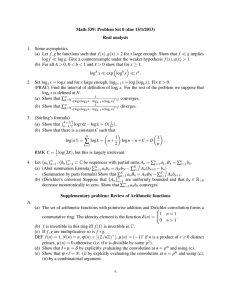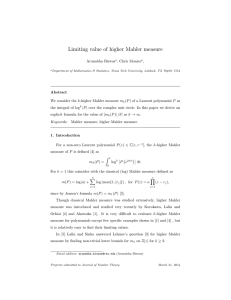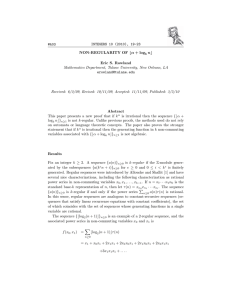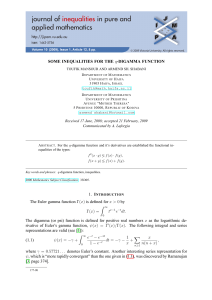Unambiguous parallel computation with short witnesses Jeffrey Finkelstein Computer Science Department, Boston University
advertisement
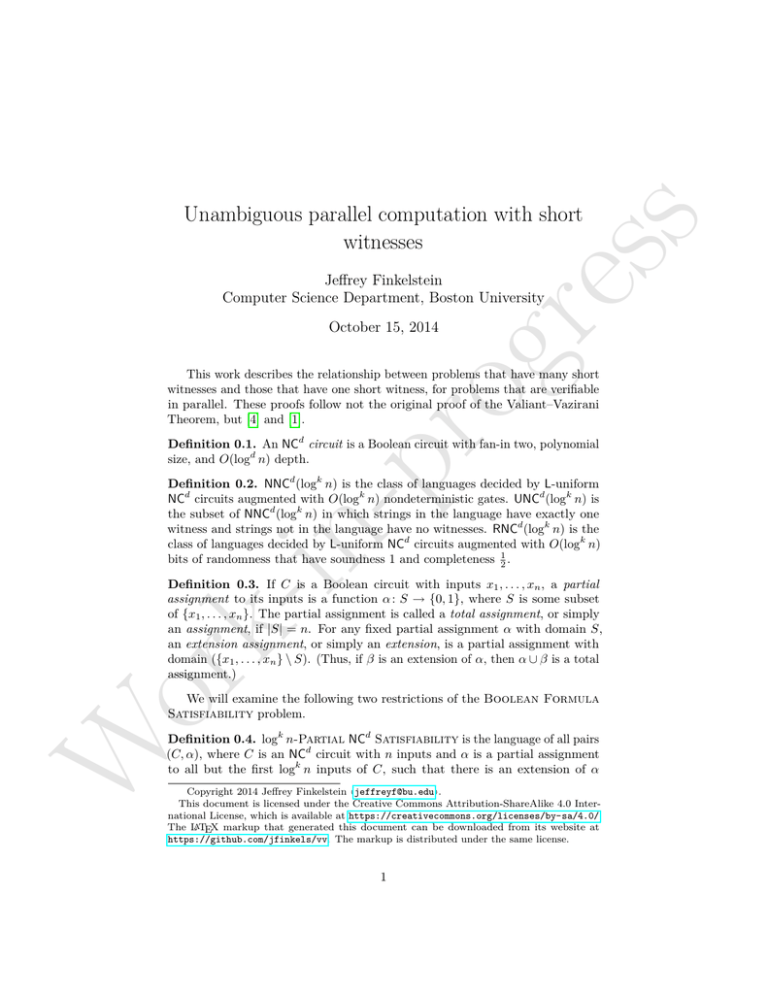
og
re
ss
Unambiguous parallel computation with short
witnesses
Jeffrey Finkelstein
Computer Science Department, Boston University
October 15, 2014
pr
This work describes the relationship between problems that have many short
witnesses and those that have one short witness, for problems that are verifiable
in parallel. These proofs follow not the original proof of the Valiant–Vazirani
Theorem, but [4] and [1].
Definition 0.1. An NCd circuit is a Boolean circuit with fan-in two, polynomial
size, and O(logd n) depth.
in
-
Definition 0.2. NNCd (logk n) is the class of languages decided by L-uniform
NCd circuits augmented with O(logk n) nondeterministic gates. UNCd (logk n) is
the subset of NNCd (logk n) in which strings in the language have exactly one
witness and strings not in the language have no witnesses. RNCd (logk n) is the
class of languages decided by L-uniform NCd circuits augmented with O(logk n)
bits of randomness that have soundness 1 and completeness 12 .
W
or
k-
Definition 0.3. If C is a Boolean circuit with inputs x1 , . . . , xn , a partial
assignment to its inputs is a function α : S → {0, 1}, where S is some subset
of {x1 , . . . , xn }. The partial assignment is called a total assignment, or simply
an assignment, if |S| = n. For any fixed partial assignment α with domain S,
an extension assignment, or simply an extension, is a partial assignment with
domain ({x1 , . . . , xn } \ S). (Thus, if β is an extension of α, then α ∪ β is a total
assignment.)
We will examine the following two restrictions of the Boolean Formula
Satisfiability problem.
Definition 0.4. logk n-Partial NCd Satisfiability is the language of all pairs
(C, α), where C is an NCd circuit with n inputs and α is a partial assignment
to all but the first logk n inputs of C, such that there is an extension of α
Copyright 2014 Jeffrey Finkelstein ⟨jeffreyf@bu.edu⟩.
This document is licensed under the Creative Commons Attribution-ShareAlike 4.0 International License, which is available at https://creativecommons.org/licenses/by-sa/4.0/.
The LATEX markup that generated this document can be downloaded from its website at
https://github.com/jfinkels/vv. The markup is distributed under the same license.
1
that satisfies C. Unambiguous logk n-Partial NCd Satisfiability is the
restriction of the above language to only those pairs for which there is at most
one satisfying assignment.
logk n-Partial NCd Satisfiability is complete for NNCd (logk n); its unambiguous restriction is in UNCd (logk n). (When k = 1 and d = 1, the former
problem is equivalent to Boolean Formula Evaluation.)
Definition 0.5. A collection of functions Hn,m from {0, 1}n to {0, 1}m is a
pairwise independent hash family if for all distinct x1 and x2 in {0, 1}n and all
y1 and y2 in {0, 1}m ,
Pr
R
[h(x1 ) = y1 ∧ h(x2 ) = y2 ] =
h←Hn,m
1
22m
.
A pairwise independent hash family is called NCd -explicit if the function
(h, x) 7→ h(x) is computable in NCd .
Lemma 0.6. There is an NCd -explicit pairwise independent hash family for all
d >???.
Proof. There is a simple construction of an NC2 pairwise independent hash
family. The collection of functions defined by Hn,m = {hA,b | hA,b (x) = Ax + b},
where A is an m × n Boolean matrix and b is an m-dimensional bit vector, is a
well-known pairwise independent hash family. Boolean matrix multiplication is
computable in NC2 , so this family is NC2 -explicit.
I believe we can also construct NC0 pairwise independent hash families, using
[2] and [3] (TODO explain this).
Lemma 0.7. Suppose n and m are positive integers, Hn,m is a pairwise independent hash family, and S is a subset of {0, 1}n . If 2m−2 ≤ |S| ≤ 2m−1
then
1
Pr [there is a unique x ∈ S such that h(x) = 0m ] ≥ .
R
8
h←Hn,m
The specific string 0m in the previous lemma is irrelevant; any fixed binary
string would work just as well.
Theorem 0.8 (Valiant–Vazirani). There is a probabilistic logarithmic space
computable function f such that for all NCd circuits C on n inputs, and all
partial assignments α to all but the first logk n of the inputs, the following
conditions are satisfied.
• f (C, α) outputs a circuit C 0 and a partial assignment to its inputs α0 .
• If there is an extension of α that satisfies C then with probability at least
1
there is a unique extension of α0 that satisfies C 0 .
8 logk n
• If there is no extension of α that satisfies C then with probability 1 there
is no extension of α0 that satisfies C 0 .
2
The probabilities are over the uniform random bits used by f .
Proof. Let Hlogk n,m be an NCd -explicit pairwise independent hash family as
guaranteed by Lemma 0.6. Define the function f as follows on input circuit C
and partial assignment given as bits xlogk n+1 , . . . , xn .
1. Choose m uniformly at random from {2, . . . , logk n + 1}.
2. Choose h uniformly at random from Hlogk n,m .
3. Let C 0 (x1 , . . . , xn ) be the circuit computing
(C(x1 , . . . , xn ) = 1) ∧ (h(x1 ◦ · · · ◦ xlogk n ) = 0m ).
(We only use the the first logk n bits of the input in the hash function
because we expect a partial assignment to fix the value of the remaining
inputs.)
4. Output C 0 and the same partial assignment α.
The probability that m is chosen such that the number of satisfying assignments
to the original circuit C is between 2m−2 and 2m−1 is log1k n . Conditioned on
that event, the probability that h is chosen as in Lemma 0.7 is at least 18 . Thus
if there is an extension of α satisfying C then the probability that there is a
unique extension satisfying C 0 is at least 8 log1 k n . If the original circuit has
no satisfying extension, then neither does C 0 , so the probability that C 0 has a
satisfying extension is 0.
The efficiency of f is merely the efficiency of constructing the relatively simple
circuit C 0 , and so can be computed in logarithmic space. Finally, f uses log logk n
random bits, or k log log n bits, to choose m (in binary) and uses O(logk n)
random bits to choose h (TODO explain why: see Pseudorandomness).
Thus the total number of random bits used is O(logk n + log log n).
Corollary 0.9. Let d be a positive integer (greater than ...) and k be any nonnegative integer. If NCd = UNCd (logk n) then NNCd (logk n) ⊆ RNCd (log2k n),
and furthermore NNCd (polylog) = RNCd (polylog).
Proof. The “furthermore” part of the conclusion follows from the syntactic
inclusion RNCd (logk n) ⊆ NNCd (logk n), so we will prove that the hypothesis
implies NNCd (logk n) ⊆ RNCd (log2k n).
This is a corollary of the proof of the previous theorem. It suffices to show an
RNCd algorithm for logk n-Partial NCd Satisfiability, which is a complete
problem for NNCd (logk n) under logarithmic space many-one reductions. By
hypothesis, there is an NCd algorithm, call it U , that decides Unambiguous
logk n-Partial NCd Satisfiability, which is in UNCd (logk n).
Consider the function f from the proof of the previous theorem. Instead
of choosing m at random in the first step of the function f , we will try all
possible values of m in parallel in order to find the correct number of satisfying
assignments. Consider an algorithm, call it A, that proceeds as follows on inputs
C and α.
3
1. For each m ∈ {2, . . . , logk n + 1} in parallel:
(a) Choose h uniformly at random from Hlogk n,m .
0
(b) Let Cm
be the circuit whose construction was described in the previous
theorem (that is, step 3 of the definition of f ).
2. Accept if and only if
k
log_
n+1
0
U (Cm
, α) = 1.
m=2
If there is at least one satisfying extension for C, then exactly one of the m
will correspond to the correct number of extensions (specifically, there will be
exactly one m such that the number of extensions is between 2m−2 and 2m−1 ).
0
The probability that U will accept that Cm
is at least 18 , by Lemma 0.7, so A
0
will accept with at least that probability (since it accepts if any of the U (Cm
, α)
output 1). As before, if C has no satisfying extensions then neither does any of
the C 0 , so A rejects with probability 1.
In order to get the completeness probability to be greater than 12 , we amplify
the probability of success of A by running some number of independent instances
of A in parallel and accepting if and only if at least one of the instances accepts. If
the probability that each instance accepts is at least 18 , then the probability that
each instance rejects is less than 78 . If t instances of A are run independently in
parallel, the probability that they all reject is less than ( 78 )t . Thus the probability
that at least one accepts is at least 1 − ( 78 )t . This is greater than 12 if t is at least
6. Therefore the overall algorithm, call it A0 , consists of 6 parallel instances of
A with a disjunction at the final layer.
Now we determine the efficiency of the algorithm to ensure that it is in
RNCd (log2k n). Each instance of A consists of a disjunction of O(logk n) instances
of the NCd circuit U . The inputs to each of those instances of U are the outputs
0
from Cm
, itself a conjunction of two NCd circuits (namely, the circuits for C and
h). Hence A is an NCd circuit, and the disjunction of six instances of A is also
an NCd circuit. Furthermore, the number of random bits used in A equals the
total number of bits used to choose each of the hash functions h. Each hash
function requires O(logk n) bits (TODO this is a known fact, state it), and
there are O(logk n) of them. Therefore the total number of random bits required
is O(log2k n).
TODO can we use randomness-efficient error reduction to reduce the amount
of randomness required down to O(logk n), thereby allowing the conclusion
NNCd (logk n) = RNCd (logk n) in the above corollary?
References
[1] Sanjeev Arora and Boaz Barak. Computational Complexity: A Modern
Approach. 1st ed. Cambridge University Press, 2009. isbn: 0521424267.
4
[2] Yuval Ishai et al. “Cryptography with Constant Computational Overhead”.
In: Proceedings of the 40th Annual ACM Symposium on Theory of Computing.
STOC ’08. Victoria, British Columbia, Canada: ACM, 2008, pp. 433–442.
isbn: 978-1-60558-047-0. doi: 10 . 1145 / 1374376 . 1374438. url: http :
//doi.acm.org/10.1145/1374376.1374438.
[3] Daniel A Spielman. “Linear-time encodable and decodable error-correcting
codes”. In: IEEE Transactions on Information Theory 42.6 (1996), pp. 1723–
1731.
[4] Luca Trevisan. CS254 Lecture 7 — Valiant–Vazirani. Apr. 29, 2010. url:
http://lucatrevisan.wordpress.com/2010/04/29/cs254-lecture-7valiant-vazirani.
5
